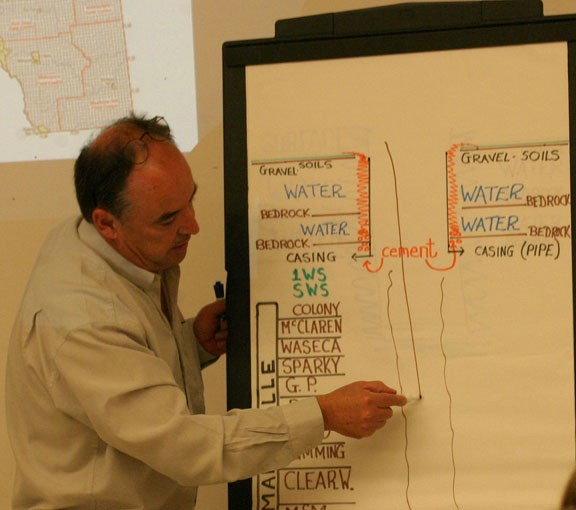The effect of industry on underground aquifers remains a topic of concern for area residents. At a LICA three-person presentation at Beaverdam Hall on Wednesday, around 70 people heard about the oil industry's attempts to keep aquifers uncontaminated.
Audience members heard about various safeguards in place regulated by the ERCB to protect water sources when drilling. However, no drilling operation is 100 per cent safe as casing failures can result from stress.
Presenters said with safeguards in place, contamination of water supplies is unlikely.
Jen Russel-Houston, a geologist working for Osum, told the crowd about oil exploration from a geologist's perspective.
She displayed seismic data from the area and showed how scientists try to identify underground channels – and how they theorize about what's below peoples' feet.
Russel-Houston said she hoped her presentation would help people understand what's below them.
“We're actually doing a lot of good work to make sure it's being done in a way that's respectable to people that live here and the environment,” she said after the meeting.
Osum does not operate near Beaverdam, but expects production to start at its Taiga project near Cold Lake by 2014.
Don Hennessey spoke for the ERCB. He questioned the title of the evening's presentation, “Sensitive Area Drilling,” because he said drilling is always sensitive.
He explained that industry drills through the groundwater we drink, but that it doesn't add anything to the water. The pipeline to draw oil is made of steel and cemented in place, making an underground leak very unlikely.
Seismic sensors operate near drilling operations to listen for unusual sounds underground, which could indicate a break in the casing, and help address a situation should a failure occur.
“The industry is trying to move forward in the best way possible for a safety and environmental perspective and a respected landowner (perspective),” Hennessey said after the meeting.
He said the risk of contamination to aquifers is negligible.
One woman asked about the effect of ground disturbance and whether it could contribute to arsenic in the water. Hennessey replied that a “filter cake” barrier composed of clay separated drilling activities from water supplies.
Richard Chabaylo from Alberta Environment told the audience that the minimum required distance for drilling from a water body is 100 metres, or in some case 300 metres.
After presentations, a Q & A session started. One man asked why, if there is so much oil in Alberta, industry drills under recreational lakes. Another person asked what's to stop something from the Athabasca fish deformations from happening locally.
“Basically our requirements state that if there is any possibility that you will be encountering an aquifer while drilling, you have to set surface casing,” said ERCB spokesman Bob Curran in an interview with the Nouvelle.
The surface casing aims to stop anything from the well bore from getting in the water.



